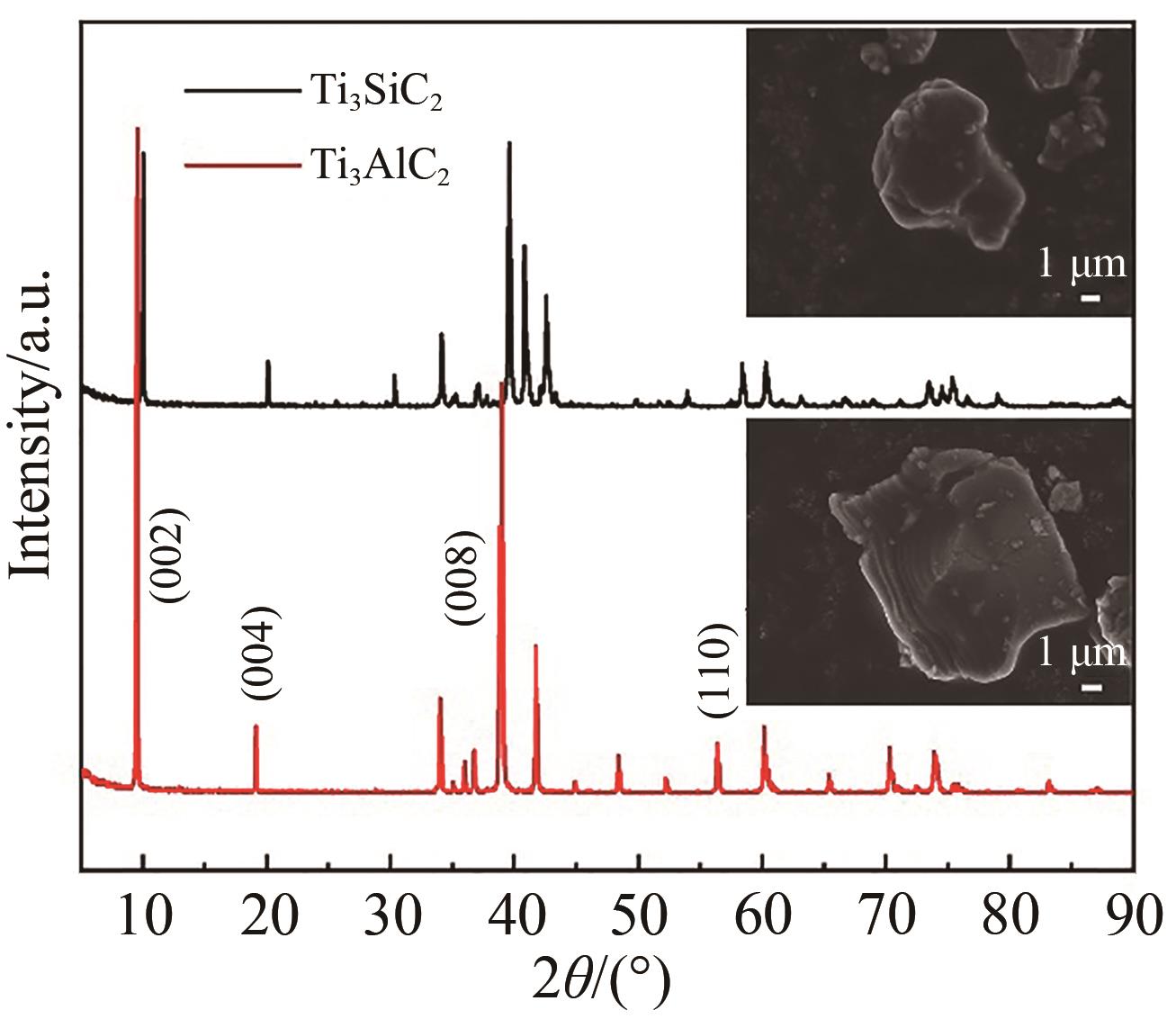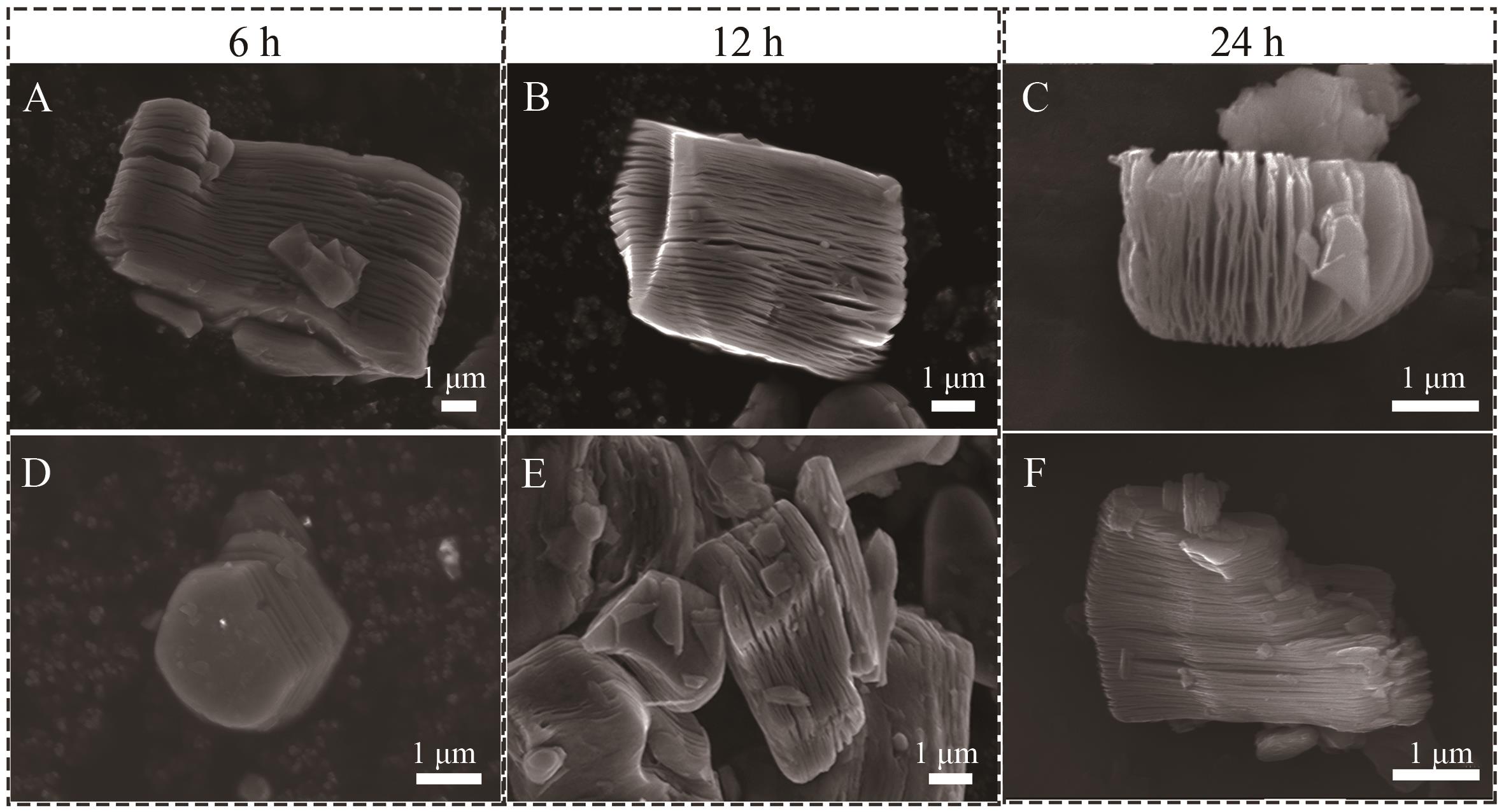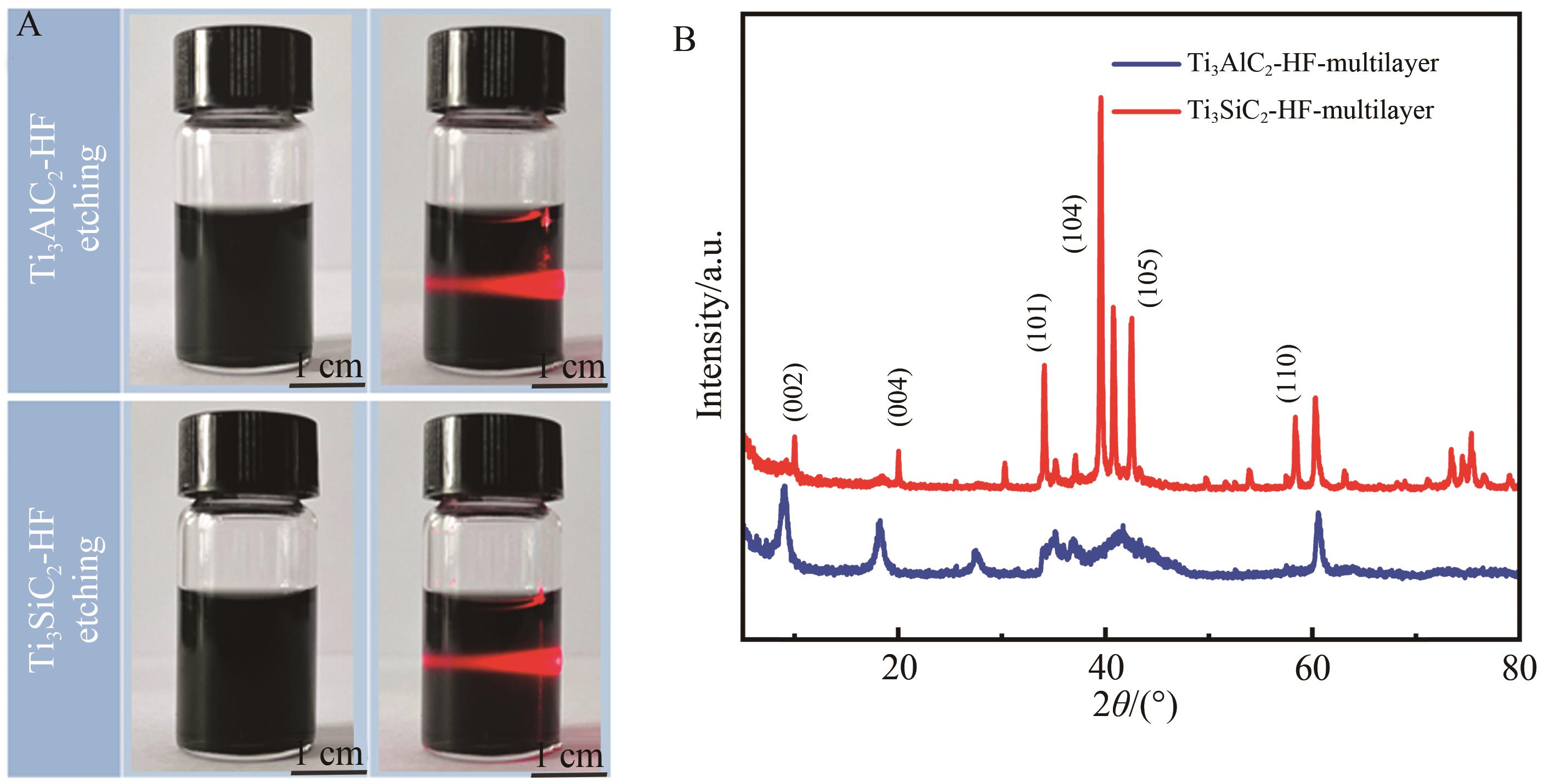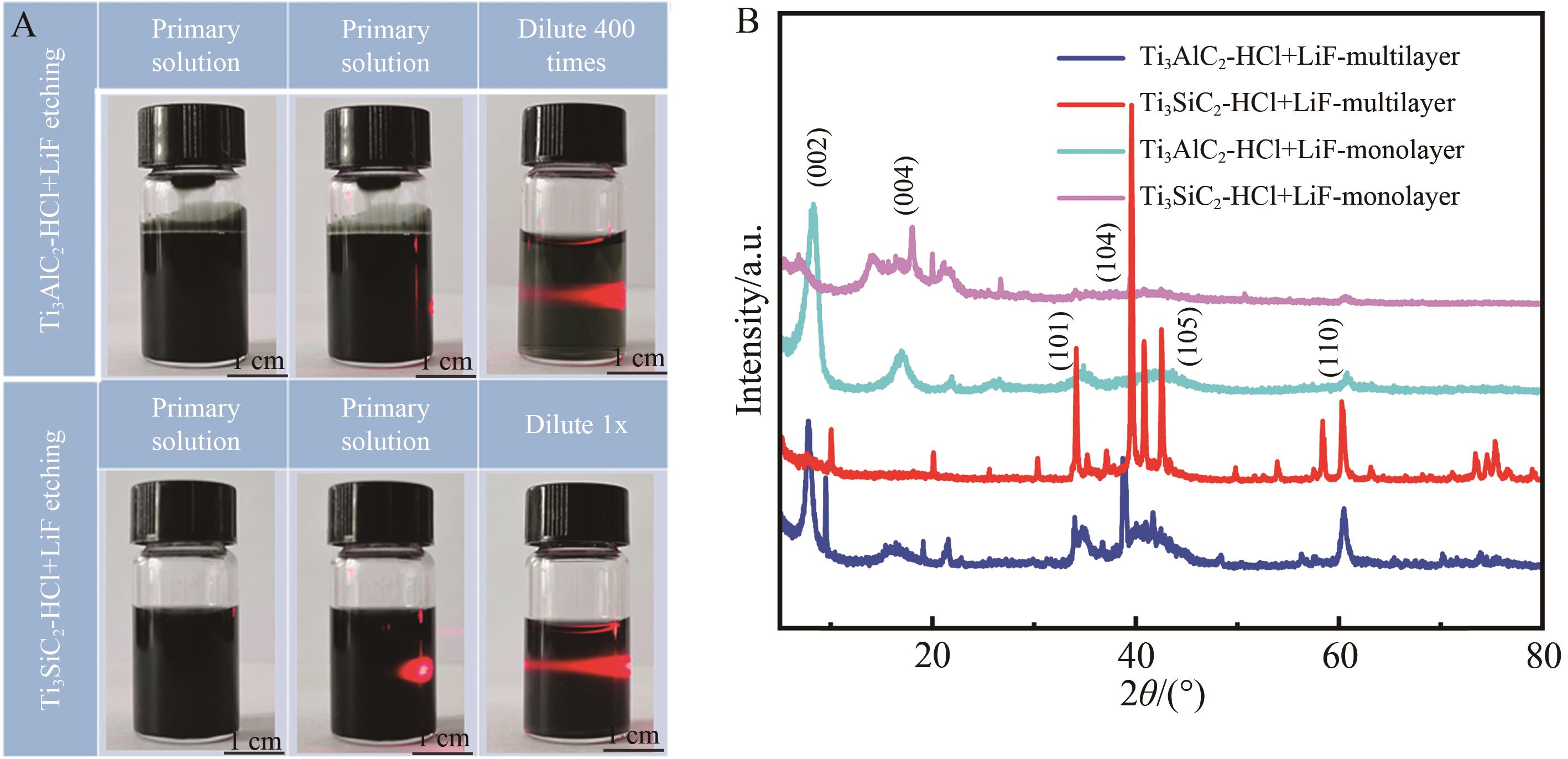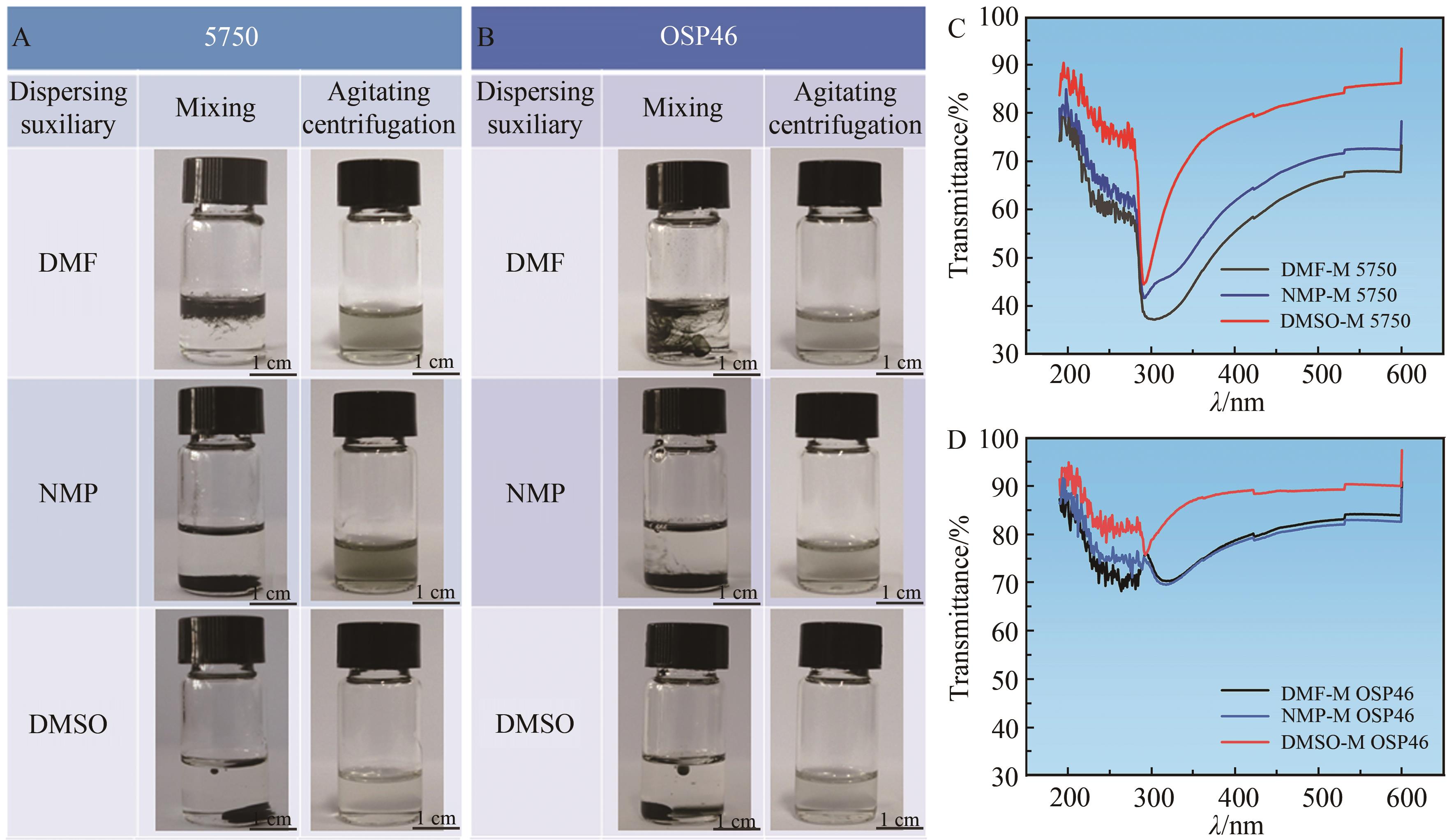
Chinese Journal of Applied Chemistry ›› 2023, Vol. 40 ›› Issue (7): 1044-1053.DOI: 10.19894/j.issn.1000-0518.230064
• Full Papers • Previous Articles Next Articles
MXenes Etching Method and Dispersion in Organic Solvents
Wen-Wen MA1,2, Tong-Yang LI1, Hua-Guo TANG1, Zhu-Hui QIAO1( )
)
- 1.State Key Laboratory of Solid Lubrication,Lanzhou Institute of Chemical Physics,Chinese Academy of Sciences,Lanzhou 730000,China
2.University of Chinese Academy of Sciences,Beijing 100039,China
-
Received:2023-03-17Accepted:2023-06-02Published:2023-07-01Online:2023-07-19 -
Contact:Zhu-Hui QIAO -
About author:zhqiao@licp.cas.cn
-
Supported by:the Shandong Provincial Natural Science Foundation(ZR2021JQ20);the National Key R&D Program of China(2022YFB3706204)
CLC Number:
Cite this article
Wen-Wen MA, Tong-Yang LI, Hua-Guo TANG, Zhu-Hui QIAO. MXenes Etching Method and Dispersion in Organic Solvents[J]. Chinese Journal of Applied Chemistry, 2023, 40(7): 1044-1053.
share this article
Add to citation manager EndNote|Ris|BibTeX
URL: http://yyhx.ciac.jl.cn/EN/10.19894/j.issn.1000-0518.230064
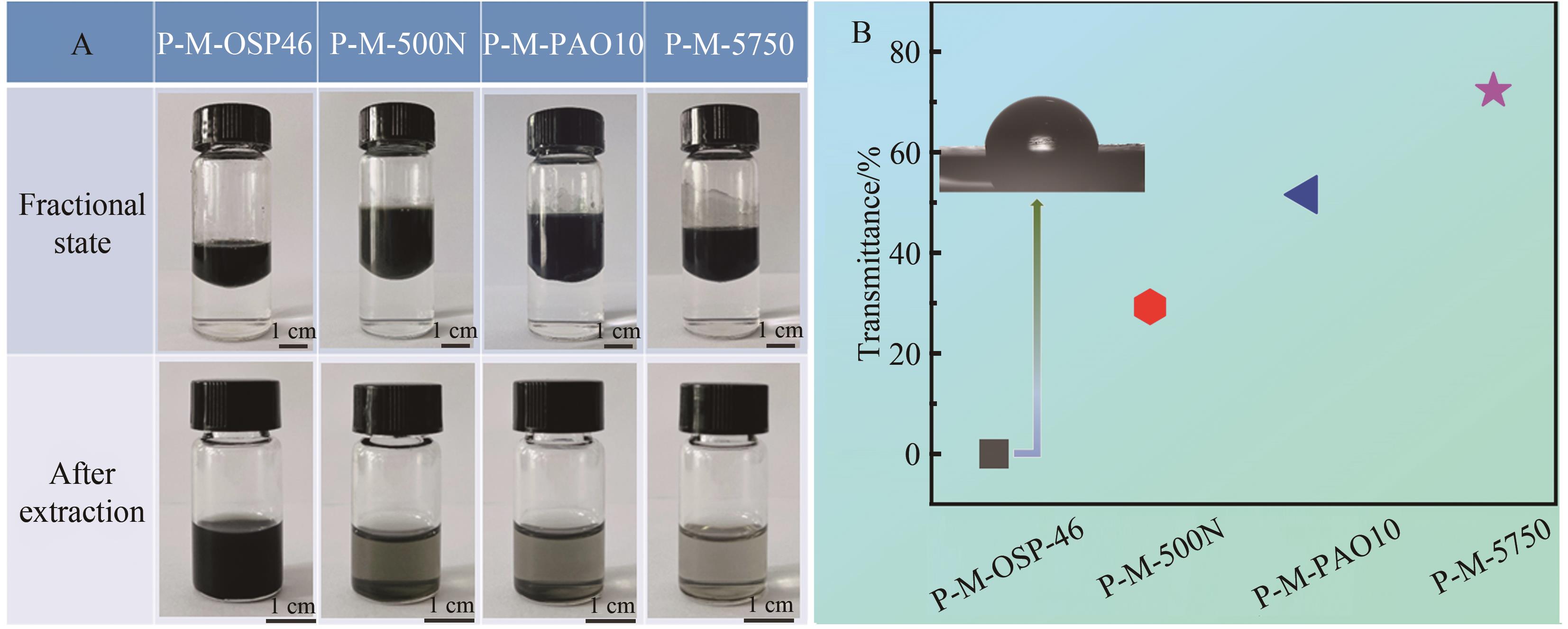
Fig.9 (A) Images and (B) transparency scatter diagram at 400 nm wavelength of alkyl phospho-modified MXenes dispersed in OSP-46, 500N, PAO10, and 5750 and the water contact angle of P-M-OSP-46
| 1 | 高利芳, 宋忠乾, 孙中辉, 等. 新型二维纳米材料在电化学领域的应用与发展[J]. 应用化学, 2018, 35(3): 247-258. |
| GAO L F, SONG Z Q, SUN Z H, et al. Application and development of novel two-dimensional nanomaterials in electrochemistry[J]. Chin J Appl Chem, 2018, 35(3): 247-258. | |
| 2 | WYATT B C, ROSENKRANZ A, ANASORI B. 2D MXenes: tunable mechanical and tribological properties[J]. Adv Mater, 2021, 33(17): e2007973. |
| 3 | NAGUIB M, KURTOGLU M, PRESSER V, et al. Two-dimensional nanocrystals produced by exfoliation of Ti3AlC2[J]. Adv Mater, 2011, 23(37): 4248-4253. |
| 4 | NAGUIB M, MASHTALIR O, CARLE J, et al. Two-dimensional transition metal carbides[J]. ACS Nano, 2012, 6: 1322-1331. |
| 5 | ALHABEB M, MALESKI K, ANASORI B, et al. Guidelines for synthesis and processing of two-dimensional titanium carbide (Ti3C2Tx MXene)[J]. Chem Mater, 2017, 29 (18):7633-7644. |
| 6 | SANG X, XIE Y, LIN M W, et al. Atomic defects in monolayer titanium carbide (Ti3C2Tx) MXene[J]. ACS Nano, 2016, 10(10): 9193-9200. |
| 7 | HAN M, SHUCK C E, RAKHNANOVR, et al. Beyond Ti3C2Tx: MXenes for electromagnetic interference shielding[J]. ACS Nano, 2020, 14(4): 5008-5016. |
| 8 | STOLLER M D, PARK S, ZHU Y, et al. Graphene-based ultracapacitors[J]. Nano Lett, 2008, 8: 3498-3502. |
| 9 | ALHABEB M, MALESKI K, MATHIST S, et al. Selective etching of silicon from Ti3SiC2 (MAX) to obtain 2D titanium carbide (MXene)[J]. Angew Chem, 2018, 57(19): 5444-5448. |
| 10 | URBANKOWSKI P, ANASORIB, MAKARYANT, et al. Synthesis of two-dimensional titanium nitride Ti4N3 (MXene)[J]. Nanoscale, 2016, 8(22): 11385-11391. |
| 11 | LI Y, SHAO H, LIN Z, et al. A general Lewis acidic etching route for preparing MXenes with enhanced electrochemical performance in non-aqueous electrolyte[J]. Nat Mater, 2020, 19(8): 894-899. |
| 12 | KAMUSBAYEVV, FILATOVA S, HU H, et al. Covalent surface modifications and superconductivity of two-dimensional metal carbide MXenes[J]. Science, 2020, 369(6506): 979-983. |
| 13 | MASHTALIRO, COOKK M, MOCHALINV N, et al. Dye adsorption and decomposition on two-dimensional titanium carbide in aqueous media[J]. J Mater Chem A, 2014, 2(35): 14334-14338. |
| 14 | MALESKI K, MOCHALIN V N, GOGOTIS Y. Dispersions of two-dimensional titanium carbide MXene in organic solvents[J]. Chem Mater, 2017, 29(4): 1632-1640. |
| 15 | KIM D, KO T Y, KIM H, et al. Nonpolar organic dispersion of 2D Ti3C2Tx MXene flakes via simultaneous interfacial chemical grafting and phase transfer method[J]. ACS Nano, 2019, 13(12): 13818-13828. |
| 16 | 武卫明, 张长松, 侯绍刚, 等. MXenes及MXenes复合材料的制备及其在能量存储与转换中的应用[J]. 应用化学, 2018, 35(3): 317-327. |
| WU W M, ZANG C S, HOU S G, et al. Synthesis of MXenes and MXenes-containing composites for energy storage and conversions[J]. Chin J Appl Chem, 2018, 35(3): 317-327. | |
| 17 | GHIDIU M, LUKATSKAYA M R, ZHAO M Q, et al. Conductive two-dimensional titanium carbide ‘clay’ with high volumetric capacitance[J]. Nature, 2014, 516(7529): 78-81. |
| 18 | SHUCK C E, SARYCHEVA A, ANAYEE M, et al. Scalable synthesis of Ti3C2Tx MXene[J]. Adv Eng Mater, 2020, 22(3): 1901241. |
| 19 | LI J, YUAN X, LIN C, et al. Achieving high pseudocapacitance of 2D titanium carbide (MXene) by cation intercalation and surface modification[J]. Adv Energy Mater, 2017, 7(15): 1602725. |
| 20 | 黄继梅, 孟瑞晋, 杨金虎. 硫掺杂二氧化钛/碳化钛复合材料的制备及储锂性能[J]. 应用化学, 2018, 35(8): 925-931. |
| HUANG J M, MENG R J, YANG J H. Preparation and lithium ion storage performance of sulfur-doped titanium dioxide/titanium carbide composite[J]. Chin J Appl Chem, 2018, 35(8): 925-931. | |
| 21 | WANG H, ZHANG J, WU Y, et al. Surface modified MXene Ti3C2 multilayers by aryl diazonium salts leading to large-scale delamination[J]. Appl Surf Sci, 2016, 384: 287-293. |
| 22 | 张晋红, 石奎, 徐鹏, 等. 仿生表面液固界面摩擦力的动态调控[J]. 应用化学, 2022, 39(1): 188-195. |
| ZHANG J H, SHI K, XU P, et al. Regulation of friction force of a water droplet on bioinspired surface[J]. Chin J Appl Chem, 2022, 39(1): 188-195. |
| [1] | Nan-Yu LIN, Feng GAO, Jiang-Ying QU, Jing-Jing TU, Wei-Jun ZHONG, Yun-Hao ZANG. Preparation of Super-hydrophilic/Underwater Oil-phobic High Silicon Cloth and Its Oil-water Separation Performance [J]. Chinese Journal of Applied Chemistry, 2023, 40(3): 449-459. |
| [2] | Bing-Gang CHEN, San-Rong LIU, Zi-Jiang JIANG, Xi-Fei YU. Preparation and Properties Characterization of Hydrophilic Polysiloxane and Polyvinyl Alcohol Composite as Skin Barrier Material [J]. Chinese Journal of Applied Chemistry, 2022, 39(8): 1224-1236. |
| [3] | HUAI Meng-Jiao, LIU Tao-Xue-Ting, JIANG Zhong-Yi. Research Progress of Artificial Water Channels Inspired by Aquaporin [J]. Chinese Journal of Applied Chemistry, 2022, 39(1): 99-109. |
| [4] | MA Antong, FU Chao, CHU Huiying, RAN Xianghai, NIE Wei. Fabrication and Piezoelectric Properties of Polyvinylidene Fluoride Composites with High β Phase [J]. Chinese Journal of Applied Chemistry, 2020, 37(12): 1411-1419. |
| [5] | CHENG Xiaodong, ZHANG Zheng. Preparation and Chromatographic Evaluation of a L-Isoleucine-Bonded Chromatographic Stationary Phase [J]. Chinese Journal of Applied Chemistry, 2019, 36(6): 726-732. |
| [6] | SUN Qi, WANG Liqiu, LIU Yang, GUO Chenxiao, WANG Pengjun, LIU Xuelong, ZHANG Xiaobo, ZHENG Lihui, LIU Liping. Preparation and Properties of Near Infrared Polyvinyl Alcohol Fluorescent Polymer Materials [J]. Chinese Journal of Applied Chemistry, 2018, 35(1): 53-59. |
| [7] | LI Chong,CHEN Ying,XIE Nuohua,LIU Junxia,FAN Cheng,ZHOU Qiyuan,ZHU Mingqiang. Research Progress on Hydrophilic Photoswitchable Fluorescent Diarylethenes [J]. Chinese Journal of Applied Chemistry, 2017, 34(12): 1379-1402. |
| [8] | WANG Sheng, QIU Na, ZHANG Pengchao, TANG Kun, ZHANG Fuli. Synthesis and Cell markers of Novel Water-soluble Asymmetric Fluorescent Dyes with Nonionic Hydrophilic Group [J]. Chinese Journal of Applied Chemistry, 2016, 33(1): 32-38. |
| [9] | FAN Xuge, LI Guocai, CHENG Chaoqun, HU Jie*. Progress in Controlled Fabrication Techniques and Applications of Silicon Nanowires Associated with Metal-assisted Chemical Etching [J]. Chinese Journal of Applied Chemistry, 2013, 30(11): 1257-1264. |
| [10] | ZHANG Zhihui1,2, HE Junhui1*, YANG Qiaowen2. Surfactant-assisted Preparation of Mechanically Durable Superhydrophilic Antireflective Silica Nanoparticle Coatings by Acid Catalyzed Sol-Gel Process [J]. Chinese Journal of Applied Chemistry, 2013, 30(07): 794-800. |
| [11] | LOU Shaofeng1, ZHANG Hua1, ZHANG Peipei1, TIAN Liqiang1, NIE Huali1, QUAN Jing1,2*, ZHU Limin1*. Synthesis and Temperature Sensitivity of N-isopropylacryamide Copolymers with Glucose Pendant [J]. Chinese Journal of Applied Chemistry, 2013, 30(04): 408-412. |
| [12] | XIAO Gu-Qing1,2*, WANG Jiao-Liang1, LONG Li-Ping1, CAI Ling1. Adsorption of Phenylamine by Hydrophobic-Hydrophilic Polydivinylbenzene/poly(acrylic acid) Polymeric Macroporous Network Resin [J]. Chinese Journal of Applied Chemistry, 2010, 27(12): 1451-1456. |
| [13] | HUANG Hong*, LEI Ming, HUANG Wei-Xin, CHEN Huan-Qin. Superhydrophilic TiO2 Film Prepared with the Assistance of Complexing Agents [J]. Chinese Journal of Applied Chemistry, 2010, 27(11): 1322-1327. |
| [14] | LIU Xiao-Jing, BANG Yin*, LIU Zheng-Yin, LIU Shu-Hua. Controlled-Synthesis of CuC2O4 Porous Spheres [J]. Chinese Journal of Applied Chemistry, 2010, 27(03): 333-337. |
| [15] | JIANG Guo-Min, ZHAO Qun, GU Xue-Fang, ZHANG Yu, WANG Xu-Rong, GE Cun-Wang. Study on Complexes of Natural Rubber Latex Blended with Hydrophilic Organosiloxane [J]. Chinese Journal of Applied Chemistry, 2010, 27(02): 151-154. |
| Viewed | ||||||
|
Full text |
|
|||||
|
Abstract |
|
|||||
